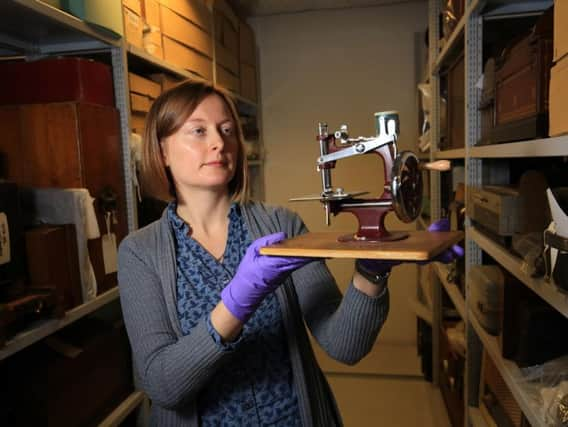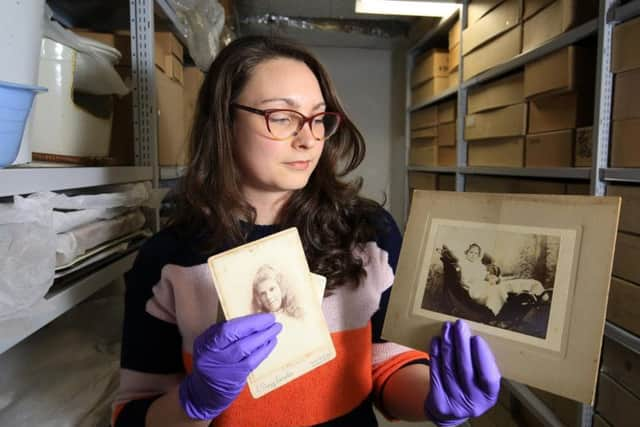Collecting the history of Sheffield society at museums store


"Before the 1960s, history was about kings and queens, and wars - all the stuff that represents our life, and the rest of us, wasn't so valued. Or it was classed as bygone: interesting things that people used to do, like strange agricultural equipment. That's how social history museums used to be; things that have 'gone'."
These days, says the curator of social history at Museums Sheffield, there is a willingness to give an account of people's everyday lives, keeping objects that reflect the normal - but no less important - existences of city residents from all backgrounds.


Advertisement
Hide AdAdvertisement
Hide Ad"Not everyone will connect with art, or a natural history object, or a shiny candlestick, but they might look at a 1963 Beatles ticket and say 'That was me!' It's got a different power."
Clara is in charge of a collection of around 25,000 items preserved at the museums' store, the location of which is not widely publicised for security reasons. Last year the council announced its intention to upgrade the Graves Gallery and Central Library in the city centre, turning it into a landmark 'cultural hub' after the idea of creating a five-star hotel at the building with Chinese investment money failed to gain momentum.
In the second of five special weekly features, The Star takes a look at how Museums Sheffield wants to make more of its huge archive as the gallery redevelopment plans take shape.


Objects in the social history collection date from the 1500s to the present day. The oldest are mainly on display at Bishops' House in Norton Lees, while many others are exhibited at Weston Park Museum, where the Sheffield Life & Times gallery underwent a revamp in 2016, bringing changing displays alongside old favourites including the butcher's shop, Victorian yard and a kitchen transplanted from an original Park Hill flat.
Advertisement
Hide AdAdvertisement
Hide Ad"It's not the biggest collection, but it's not the smallest," says Clara. "The most recent things we've collected are probably part of the new protest exhibition at Weston Park Park, like the tree protest things."
Items are kept in boxes, stored on large 'roller racks' that open out at the turn of a wheel. A glance at the pieces of paper pinned to the end of each rack reveals the collection's diversity - toys, clothes, radios, photos and household furnishings are all waiting to be rummaged through.
"It's meant to tell people's stories - in effect, everyday life in Sheffield," Clara explains. "The policy now is an item must have Sheffield provenance, with a story attached, or maybe it's come from a Sheffield person."
She points to a miniature stove designed for a child to play with generations ago. "Kids used to have these little toy cooking sets. You could put a lit candle in and boil some water... and probably set fire to the house."
Advertisement
Hide AdAdvertisement
Hide AdOne of her latest projects is a 1960s display for the Sheffield Life & Times gallery. A vibrantly-coloured dress, donated by a woman who was a teenager at the time, is draped over a mannequin while its condition is checked.
"There's a few dresses that she gave us, and some shoes and things. She was in Sheffield in the 60s so it's got really good provenance."
The dress would be perfectly wearable today, she agrees. "Mini dresses are coming in again," she nods. "The display is in its early stages, but the items are quite cool and colourful."
Meanwhile curatorial assistant Olivia Froment is sorting through pictures salvaged from the floods in 2007.
Advertisement
Hide AdAdvertisement
Hide Ad"There was quite a lot of ephemera that was involved in the flood and damaged, so I've been going through it and cataloguing it. We knew where it was in the store, vaguely, but we couldn't go to a box and say 'I know what's in there'. I've been finding some really great photographs."
One picture shows Leader House - the museums' city centre base, built by the Duke of Norfolk and leased in the 1700s by silversmith Thomas Leader - as it once was, surrounded by buildings that have now vanished.
"We shared that on social media, it got really good engagement," Olivia says eagerly.
A view of King Edward VII school in Broomhill and the surrounding area has been set aside for a colleague who's writing a history of the Botanical Gardens.
Advertisement
Hide AdAdvertisement
Hide Ad"There was one of St Mary's Gate I found and it was all terraced houses. It looked completely different. People love seeing these views online, they get a really great reaction."
The eye is understandably drawn to a Victorian photo of a lady 'possibly just about to die'. "She's propped up, so I don't think she's actually dead," Clara observes drily. "These are the kinds of things we wonder about. They seemed to photograph the big events."
It's simply too difficult to pick a favourite object from the collection, Clara feels.
"It's hard because you can pick any object and just get absorbed. The collection's really good because people can connect to it and reminisce about it, and can remember their youth or things their grandma told them. The toy case at the museum has things I remember from my childhood. It goes across time."
Advertisement
Hide AdAdvertisement
Hide AdShe is now constantly approached by people wishing to donate potential exhibits, which entails assessing the story behind them, and whether duplicates are already waiting in storage.
The big question, she believes, is what should be kept to evoke life in 2018.
"You don't want to collect too many dead ends - but you don't want to miss anything either. There's always more stored than there is on display, but because we've got the gallery we can swap things round. We could have twice as much space. It's the history of Sheffield, it's enormous."
